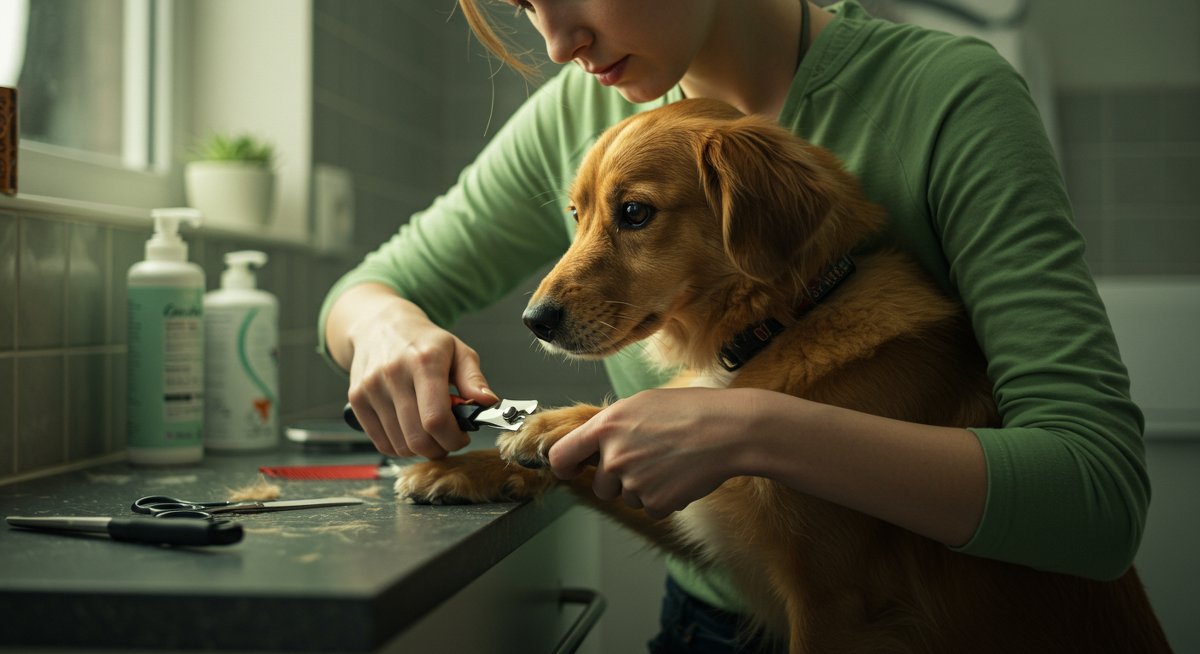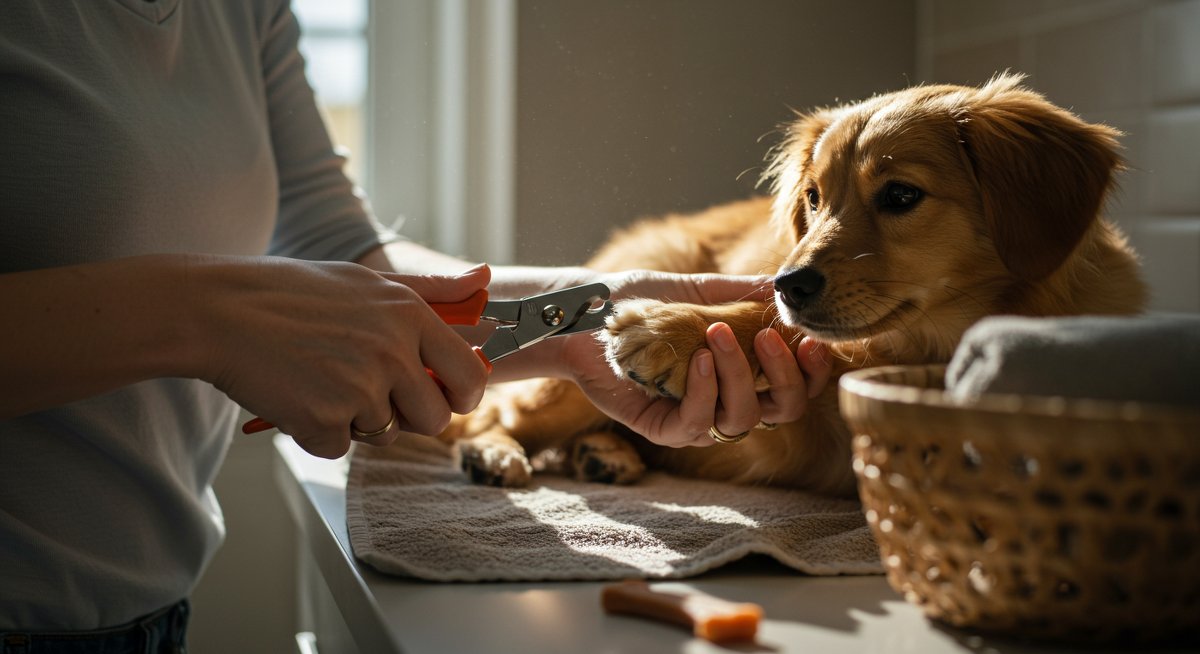Bringing a new dog into your life is a joy, but it also comes with new responsibilities. One of the most important, yet often overlooked, aspects of dog care is nail trimming. Keeping your dog's nails at a healthy length is crucial for their comfort, mobility, and overall well-being. This guide is specifically designed for new pet owners like you, providing you with all the essential information, tips, and techniques you need to safely and confidently trim your dog's nails at home.

Why understanding dog nail trimming is crucial for your new pet
As a new dog owner, you'll quickly realise that dog nail trimming isn't just about aesthetics; it's a fundamental part of responsible pet ownership. Overgrown nails can cause a variety of problems for your furry friend. They can curl under, causing pain and making it difficult for your dog to walk or run. In more severe cases, overgrown nails can even affect their posture and lead to joint issues. Imagine wearing shoes that are too tight all the time—it's the same kind of discomfort.
Beyond the physical discomfort, overgrown nails can also increase the risk of injury. They can get caught on carpets, clothing, or other surfaces, leading to torn nails and bleeding. This can be a distressing experience for both you and your dog. Regular nail trimming helps prevent these issues, keeping your dog happy and healthy. Furthermore, it's an excellent opportunity to bond with your dog and get them used to being handled.
- Preventing Pain and Discomfort: Overgrown nails can press against the dog's toes and pads, causing pain and making walking difficult. Think about how uncomfortable it is to wear shoes that are too small; it's the same principle.
- Avoiding Injury: Long nails are more likely to get caught on things, leading to painful tears or breaks. This can cause bleeding and require veterinary attention.
- Maintaining Proper Posture: Overgrown nails can alter your dog's gait and posture, potentially leading to joint issues over time.
Essential first steps for dog nail care
Before you even pick up the clippers, there are a few essential steps to take to ensure a positive experience. First and foremost, you need to get your dog comfortable with the idea of having their paws handled. This means gently touching their paws, massaging their toes, and rewarding them with treats. This process should be done frequently, even when you're not planning to trim their nails. It's all about building trust and positive associations.
Next, gather the right tools. You'll need dog nail clippers (either guillotine-style or scissor-style – we'll discuss this below), styptic powder (in case you accidentally cut the quick), treats to reward your dog, and a comfortable space to work in. Make sure you have good lighting so you can clearly see what you're doing. Consider doing the first few trims with a friend or family member who can assist you. You can also consider using a grooming table if you have one, but it's not essential.
- Acclimation: Start by touching your dog's paws frequently, even when not trimming. Pair this with positive reinforcement, like treats and praise, to build trust.
- Tool Gathering: Acquire appropriate nail clippers, styptic powder for emergencies, high-value treats, and good lighting.
- Setting Up the Environment: Choose a quiet, comfortable space where your dog feels safe. Having a helper can make the process easier, especially for beginners.
Example: I've found that starting with just a few seconds of paw handling each day, and gradually increasing the time, works wonders. Always end on a positive note, even if you don't trim the nails. Giving your dog a tasty treat immediately after handling their paws will create a positive association with the experience. This is especially helpful for dogs who are naturally anxious or fearful.
Common challenges & how to overcome them
One of the biggest challenges new pet owners face is dealing with the "quick." The quick is the pink part of the nail that contains blood vessels and nerves. Cutting into the quick is painful for your dog and will cause bleeding. It's essential to identify the quick before trimming and avoid cutting into it.
If you have a dog with light-colored nails, the quick is usually easy to see. It appears as a pink area within the nail. However, if your dog has dark nails, identifying the quick can be more challenging. In these cases, it's best to trim small amounts at a time, observing the cut surface of the nail. As you get closer to the quick, you'll notice a small, dark dot in the center of the cut surface. This is a sign that you're getting close to the quick, and you should stop trimming.
- Anxiety and Fear: Many dogs are anxious about having their nails trimmed. Start slowly, and reward your dog with treats and praise. Consider taking breaks and gradually increasing the amount of time you spend trimming.
- Cutting the Quick: This is a common mistake. If you do cut the quick, stay calm. Apply styptic powder to the nail to stop the bleeding. If you're nervous about doing it yourself, consider having a professional groomer show you how.
- Dog's Resistance: If your dog resists, don't force it. Take breaks, try again later, or consult a professional groomer. Positive reinforcement and patience are key.
Example: A friend of mine was terrified of trimming her dog's nails, fearing she would hurt him. We started by just getting the dog used to having his paws touched, then moved on to clipping only the tips, and rewarding him with his favorite treats. After a few sessions, he got more comfortable, and now, nail trimming is a much easier process. The key was patience and creating a positive experience.
Tips for success (e.g., basic training, feeding schedules)
Choose the Right Clippers: There are two main types of dog nail clippers: guillotine-style and scissor-style. Guillotine clippers have a hole where you insert the nail, and a blade that comes down to cut it. Scissor clippers look like regular scissors but are designed for cutting nails. Consider which type works best for you and your dog.
Start Slow and Steady: Don't try to trim too much at once. Trim small amounts and check the nail frequently for the quick. It's better to trim a little bit at a time than to cut the quick.
Positive Reinforcement: Always reward your dog with treats and praise after nail trimming. This will help them associate the experience with something positive.
Get Professional Help if Needed: If you're uncomfortable trimming your dog's nails, or if your dog is particularly anxious or resistant, don't hesitate to seek professional help from a groomer or veterinarian.
Choosing the Right Clippers: Many owners prefer the guillotine-style clippers for ease of use, but scissor-style clippers provide more control, especially for smaller dogs.
Establishing a Routine: Aim to trim your dog's nails every 2-4 weeks, or as needed. Consistent care prevents nails from getting too long.
Using Treats Effectively: High-value treats like small pieces of cooked chicken or cheese can be very motivating for dogs during nail trimming sessions.
Example: My dog, a small terrier mix, was initially scared of the clippers. We started by simply letting him sniff them and then giving him a treat. We gradually worked up to touching his paws with the clippers, and then to clipping a single nail. Each successful clip was followed by a big reward. Now, he barely flinches when it's nail trimming time!
Building a strong bond with your dog
Nail trimming can be a bonding experience. By approaching it with patience, kindness, and positive reinforcement, you can help your dog associate the process with something positive. This will strengthen your bond and make future grooming sessions easier. Take the time to talk to your dog, offer reassuring words, and make the experience as pleasant as possible. This attention to detail goes a long way.
Recommended products for new owners
Dog Nail Clippers: Consider a guillotine-style or scissor-style clipper, based on your comfort and your dog's size.
Styptic Powder: Essential for stopping bleeding if you accidentally cut the quick.
High-Value Treats: Small, tasty treats to reward your dog. These should be something your dog loves.
Optional: Dog Nail Grinder: An alternative to clippers that slowly files down the nail. This can be less stressful for some dogs.
Nail Clippers: Dog Nail Clippers
Styptic Powder: Styptic Powder
Treats: High-value dog treats
Nail Grinder: Dog Nail Grinder

Quick troubleshooting guide
- Dog is Anxious: Start slowly. Desensitize your dog to the clippers by letting them sniff them. Offer treats and praise. If the anxiety is severe, consult a veterinarian or certified dog trainer.
- Bleeding: If you cut the quick, remain calm. Apply styptic powder to the nail and apply pressure. If the bleeding doesn't stop within a few minutes, contact your veterinarian.
- Dog Resists: Don't force it. Take breaks. Try again later. Consider consulting a professional groomer.
- Uneven Trimming: Trim small amounts at a time, and make sure you're cutting straight across the nail. If you're unsure, consult a professional for guidance.
Next steps in your pet parenthood journey
Now that you have a good grasp of how to trim your dog's nails, you can continue to learn and grow as a pet owner. Regular nail trimming is just one aspect of responsible dog care. Be sure to also research other essential topics such as feeding, exercise, training, and health care. Remember that every dog is different, and what works for one may not work for another. The key is to be patient, consistent, and to always prioritise your dog's well-being.